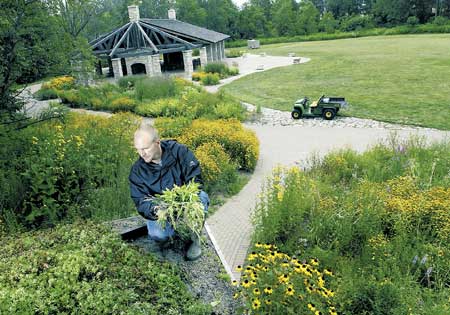

| EVAN E. PARKER / THE TIMES Steve Barker, executive director of the Coffee Creek Watershed Conservancy, removes weeds Thursday from the plant-covered roof of the restroom facility at the watershed preserve in Chesterton. The conservancy is among a growing number of green roofs, which lengthen roof life, reduce cooling costs and reduce stormwater runoff. |
Going for the green
ENVIRONMENT: Green roofs offer wear, climate and run-off advantages.This story ran on nwitimes.com on Monday, August 16, 2004 12:03 AM CDT
CHESTERTON -- Face it, roofs are a hassle. They leak and collect gutter
debris. They're expensive to maintain and replace. And they're no friend to the
environment, adding to urban "heat islands" and floods of stormwater
runoff.
But imagine roofs that cut energy costs, cleanse the air, reduce flooding and
last a long time.
A meadow-like building top in Chesterton may hint at this radically different
future.
A "green roof " -- one planted with native grasses and
drought-resistant succulents-- sits atop the restroom facility by the visitor
pavilion at Chesterton's Coffee Creek Watershed Preserve.
Featured in the summer issue of Chicago Wilderness magazine, the roof is a
modest several hundred square feet, but it is at the cusp of a potentially huge
rethinking of the high spaces that are generally out of sight, out of mind.
From energy efficiency to environmental cleansing, the seeded coverings offer a
field of advantages over a standard asphalted or shingled roof.
But perhaps their greatest value will be found in reducing the increasing
amounts of stormwater run-off that whisk pollutants and -- during heavier rains
-- the raw waste of combined sewage overflows into drinking water sources.
And their drawbacks?
"I can't think of any, honestly," says Jay Womack, a landscape
architect with Conservation Design Forum of Elmhurst, Ill., which designed both
the Coffee Creek roof and the showcase roof atop Chicago's City Hall.
One downside is that a green roof can cost twice as much or more as a standard
roof, depending on the type of building and whether it's a retrofit or a new
installation.
But while the standard roof lasts an average of 15 years, many industry experts
in the United States say a green roof can last 30 years.
The reason is they never experience the damaging effects of sun, wind, water and
ice. The green layer is like a large living blanket.
Steve Barker, director of the Coffee Creek Watershed Conservancy, says he has
experienced no problems or leaks with the four-year-old roof there. He
occasionally goes up to weed, but that's about it. And the public reaction has
been mostly one of fascination, he said.
Most green roofs are planted with sedums, low-growing succulent plants that are
shallow rooted and can tolerate dry conditions. The coverings incorporate up to
nine layers and range in depth from 3 to 18 inches. Among the layers are an
impervious liner and a root barrier that keep moisture and roots from doing
damage to the building.
The growing medium is often a non-organic material that is lighter than standard
soil. Green coverings generally add only about 25 pounds per square foot to a
roof's load, even when wet, well within the 90 pounds that most roofs can
support, Womack says.
At Indiana Dunes Environmental Learning Center in Porter, an 11,000-square-foot
education building with a green roof among its energy efficiencies has been on
the drawing board for four years but is still "several million dollars
away," says director John Hayes.
Brian Williams can be reached at bwilliams@nwitimes.com
or (219) 462-5151, ext. 348.